Exchange Currency
Bulgarian lev
The lev is the currency of Bulgaria. It is divided in 100 stotinki. In archaic Bulgarian the word „lev” meant „lion”. Bulgaria, as a member of the European Union will adopt the Euro in 2013-2014.
During World war II, in 1940, the lev was pegged to the German Reichsmark at a rate of 32.75 levs = 1 Reichsmark. With the Soviet occupation in September 1944, the lev was pegged to the Soviet ruble at 15 levs = 1 ruble. A series of pegs to the U.S. dollar followed: 120 levs = 1 dollar in October 1945, 286.50 levs in December 1945 and 143.25 levs in March 1947. No coins were issued after 1943; only banknotes were issued until the currency reform of 1952.
In 1952, following wartime inflation, a new lev replaced the original lev at a rate of 1 „new” lev = 100 „old” levs. However the rate for banking accounts was different, ranging from 100:3 to 200:1. Prices for goods were replaced at a rate of 25:1. The new lev was pegged to the U. S. dollar at a rate of 6.8 levs = 1 dollar, falling to 9.52 levs on July 29, 1957.
In 1962, another redenomination took place at the rate of 10 to 1, setting the exchange rate at 1.17 levs = 1 U. S. dollar, with the tourist rate falling to 2 levs on February 1, 1964. The ISO 4217 code was BGL. After this, the lev remained fairly stable for almost three decades. However, like other Communist countries’ currencies, it was not freely convertible for Western funds. Consequently, black market rates were five to ten times higher than the official rate .
After the fall of communism, Bulgaria experienced several episodes of drastic inflation and currency devaluation. In order to change this, in 1997, the lev was pegged to the Deutsche Mark (DEM), at a rate of 1000 levs to the Deutsche Mark.
On 5 July 1999 the lev was redenominated at 1000:1 with 1 new lev equal to 1 Deutsche Mark. The ISO 4217 currency code for the new Bulgarian lev is BGN. With the replacement of the Deutsche Mark by the euro, the lev’s peg effectively switched to the euro, at the rate of 1.95583 levs = 1 euro, which is the Deutsche Mark’s fixed exchange rate to euro. Since 1997, Bulgaria has been in a system of currency board and all Bulgarian currency in circulation has been backed 100% by the foreign exchange reserves of the Bulgarian National Bank. The rate is unlikely to change before the lev’s retirement. On 25 April 2005, when Bulgaria’s EU accession treaty was signed, the Bulgarian National Bank issued a commemorative coin with the face value of 1.95583 levs. The lev was expected to be replaced by the euro on 1 January 2012, however some recent analysis says that Bulgaria will not be able to join earlier than 2015, due to their inflation problems and the impact of the global financial crisis of 2008. However, in February 2009, The Economist suggested accelerating Bulgaria’s path to the euro, or even letting it be adopted immediately
Production of silver coins ceased in 1916, with zinc replacing cupro-nickel in the 5, 10 and 20 stotinki in 1917. In 1923, aluminum 1 and 2 levs coins were introduced, followed by cupro-nickel pieces in 1925. In 1930, cupro-nickel 5 and 10 levs and silver 20, 50 and 100 levs were introduced, with silver coins issued until 1937, in which year aluminum-bronze 50 stotinki were issued.
In 1940, cupro-nickel 20 and 50 levs were issued, followed, in 1941, by iron 1, 2, 5 and 10 levs. In 1943, nickel-clad-steel 5, 10 and 50 levs were struck. These were the last coins issued for this version of the lev.
In 1952, coins (dated 1951) were introduced in denominations of 1, 3, 5, 10 and 25 stotinki, with the lower three denominations in brass and the higher three in cupro-nickel. Cupro-nickel 20 stotinki dated 1952 were also issued, followed by 50 stotinki in 1959 and 1 lev in 1960 (both also in cupro-nickel).
In 1962, brass 1, 2 and 5 stotinki, and nickel-brass 10, 20 and 50 stotinki and 1 lev were introduced.
In 1992, a new coinage was introduced in denominations of 10, 20 and 50 stotinki, 1, 2, 5 and 10 levs. All were struck in nickel-brass except for the cupro-nickel 10 levs. In 1997, nickel-brass 10, 20 and 50 levs were introduced.
In 1999, coins in denominations of 1, 2, 5, 10, 20 and 50 stotinki were introduced. A 1 lev coin in 2002 replaced the 1 lev banknote introduced in 1999. The 1, 2 and 5 stotinki are struck in brass-plated steel, and the 10, 20 and 50 stotinki in cupro-nickel; each depicts the Madara horseman on its obverse. The 1 lev coin is bimetallic and depicts St. Ivan Rilski on its obverse.
In 1916, 1 and 2 silver levs and 1000 gold levs notes were introduced, followed by 2500 and 10,000 gold levs notes in 1919. In 1924, 5000 levs notes were issued, the first to lack a metal designation. In 1928, a new series of notes was introduced which gave the denominations solely in levs. Denominations introduced were 5, 10, 20, 50, 100, 500, 1000 and 5000 levs. These were followed in 1929 by 200 and 250 levs.
In 1930, coins up to 100 levs replaced notes, although 20 levs notes were issued between 1943 and 1950. Between 1943 and 1945, State Treasury Bills for 1000 and 5000 levs were issued.
In 1952, state notes were issued in 1, 3 and 5 levs, together with notes of the Bulgarian National Bank for 10, 20, 50, 100 and 200 levs. 500 levs notes were printed but not issued.
In 1962, the Bulgarian National Bank issued notes for 1, 2, 5, 10 and 20 levs. A second series, in the same denominations, was issued in 1974. 50 levs notes were introduced in 1990. After the fall of the communist regime, new notes were introduced for 20, 50, 100 and 200 levs. These were followed by 500 levs notes in 1993, 1000 and 2000 levs in 1994, 5000 and 10,000 levs in 1996, and 50,000 levs in 1997.
In 1999, banknotes were introduced in denominations of 1, 2, 5, 10, 20 and 50 levs. 100 levs notes were added in 2003. The 1 lev note has been replaced in everyday use by the 1 lev coin.
Summary info
Summary information about Bulgarian lev- ISO 4217 Code:
- BGN
- Currency sign:
- лв
- Country:
- Bulgaria
- Subunit:
- stotinka
- Coins:
- 1 stotinki, 2 stotinki, 5 stotinki, 10 stotinki, 20 stotinki, 50 stotinki, 1 lev
- Banknotes:
- 1 lev, 2 levs, 5 levs, 10 levs, 20 levs, 50 levs, 100 levs
- Central bank:
- Bulgarian National Bank
History
The lev was introduced as Bulgaria’s currency in 1881 with a value equal to the French franc. The gold standard was suspended between 1899 and 1906 before being suspended again in 1912. Until 1916, Bulgaria’s silver and gold coins were issued to the same specifications as those of the Latin Monetary Union. Banknotes issued until 1928 were backed by gold or silver. In 1928, a new gold standard of 1 lev = 10.86956 mg gold was established.During World war II, in 1940, the lev was pegged to the German Reichsmark at a rate of 32.75 levs = 1 Reichsmark. With the Soviet occupation in September 1944, the lev was pegged to the Soviet ruble at 15 levs = 1 ruble. A series of pegs to the U.S. dollar followed: 120 levs = 1 dollar in October 1945, 286.50 levs in December 1945 and 143.25 levs in March 1947. No coins were issued after 1943; only banknotes were issued until the currency reform of 1952.
In 1952, following wartime inflation, a new lev replaced the original lev at a rate of 1 „new” lev = 100 „old” levs. However the rate for banking accounts was different, ranging from 100:3 to 200:1. Prices for goods were replaced at a rate of 25:1. The new lev was pegged to the U. S. dollar at a rate of 6.8 levs = 1 dollar, falling to 9.52 levs on July 29, 1957.
In 1962, another redenomination took place at the rate of 10 to 1, setting the exchange rate at 1.17 levs = 1 U. S. dollar, with the tourist rate falling to 2 levs on February 1, 1964. The ISO 4217 code was BGL. After this, the lev remained fairly stable for almost three decades. However, like other Communist countries’ currencies, it was not freely convertible for Western funds. Consequently, black market rates were five to ten times higher than the official rate .
After the fall of communism, Bulgaria experienced several episodes of drastic inflation and currency devaluation. In order to change this, in 1997, the lev was pegged to the Deutsche Mark (DEM), at a rate of 1000 levs to the Deutsche Mark.
On 5 July 1999 the lev was redenominated at 1000:1 with 1 new lev equal to 1 Deutsche Mark. The ISO 4217 currency code for the new Bulgarian lev is BGN. With the replacement of the Deutsche Mark by the euro, the lev’s peg effectively switched to the euro, at the rate of 1.95583 levs = 1 euro, which is the Deutsche Mark’s fixed exchange rate to euro. Since 1997, Bulgaria has been in a system of currency board and all Bulgarian currency in circulation has been backed 100% by the foreign exchange reserves of the Bulgarian National Bank. The rate is unlikely to change before the lev’s retirement. On 25 April 2005, when Bulgaria’s EU accession treaty was signed, the Bulgarian National Bank issued a commemorative coin with the face value of 1.95583 levs. The lev was expected to be replaced by the euro on 1 January 2012, however some recent analysis says that Bulgaria will not be able to join earlier than 2015, due to their inflation problems and the impact of the global financial crisis of 2008. However, in February 2009, The Economist suggested accelerating Bulgaria’s path to the euro, or even letting it be adopted immediately
Coins
Between 1881 and 1884, bronze 2, 5 and 20 stotinki, and silver 50 stotinki, 1, 2 and 5 levs were introduced, followed, in 1888, by cupro-nickel 2½, 5, 10 and 20 stotinki. Gold 10 and 20 levs were issued in 1894. Bronze 1 stotinka were introduced in 1901.Production of silver coins ceased in 1916, with zinc replacing cupro-nickel in the 5, 10 and 20 stotinki in 1917. In 1923, aluminum 1 and 2 levs coins were introduced, followed by cupro-nickel pieces in 1925. In 1930, cupro-nickel 5 and 10 levs and silver 20, 50 and 100 levs were introduced, with silver coins issued until 1937, in which year aluminum-bronze 50 stotinki were issued.
In 1940, cupro-nickel 20 and 50 levs were issued, followed, in 1941, by iron 1, 2, 5 and 10 levs. In 1943, nickel-clad-steel 5, 10 and 50 levs were struck. These were the last coins issued for this version of the lev.
In 1952, coins (dated 1951) were introduced in denominations of 1, 3, 5, 10 and 25 stotinki, with the lower three denominations in brass and the higher three in cupro-nickel. Cupro-nickel 20 stotinki dated 1952 were also issued, followed by 50 stotinki in 1959 and 1 lev in 1960 (both also in cupro-nickel).
In 1962, brass 1, 2 and 5 stotinki, and nickel-brass 10, 20 and 50 stotinki and 1 lev were introduced.
In 1992, a new coinage was introduced in denominations of 10, 20 and 50 stotinki, 1, 2, 5 and 10 levs. All were struck in nickel-brass except for the cupro-nickel 10 levs. In 1997, nickel-brass 10, 20 and 50 levs were introduced.
In 1999, coins in denominations of 1, 2, 5, 10, 20 and 50 stotinki were introduced. A 1 lev coin in 2002 replaced the 1 lev banknote introduced in 1999. The 1, 2 and 5 stotinki are struck in brass-plated steel, and the 10, 20 and 50 stotinki in cupro-nickel; each depicts the Madara horseman on its obverse. The 1 lev coin is bimetallic and depicts St. Ivan Rilski on its obverse.
Banknotes
In 1885, the Bulgarian National Bank introduced notes for 20 and 50 gold levs, followed in 1887 by 100 gold levs and, in 1890, by 5 and 10 gold levs notes. In 1899, 5, 10 and 50 silver levs notes were issued, followed by 100 and 500 silver levs in 1906 and 1907, respectively. 500 gold levs notes were also introduced in 1907.In 1916, 1 and 2 silver levs and 1000 gold levs notes were introduced, followed by 2500 and 10,000 gold levs notes in 1919. In 1924, 5000 levs notes were issued, the first to lack a metal designation. In 1928, a new series of notes was introduced which gave the denominations solely in levs. Denominations introduced were 5, 10, 20, 50, 100, 500, 1000 and 5000 levs. These were followed in 1929 by 200 and 250 levs.
In 1930, coins up to 100 levs replaced notes, although 20 levs notes were issued between 1943 and 1950. Between 1943 and 1945, State Treasury Bills for 1000 and 5000 levs were issued.
In 1952, state notes were issued in 1, 3 and 5 levs, together with notes of the Bulgarian National Bank for 10, 20, 50, 100 and 200 levs. 500 levs notes were printed but not issued.
In 1962, the Bulgarian National Bank issued notes for 1, 2, 5, 10 and 20 levs. A second series, in the same denominations, was issued in 1974. 50 levs notes were introduced in 1990. After the fall of the communist regime, new notes were introduced for 20, 50, 100 and 200 levs. These were followed by 500 levs notes in 1993, 1000 and 2000 levs in 1994, 5000 and 10,000 levs in 1996, and 50,000 levs in 1997.
In 1999, banknotes were introduced in denominations of 1, 2, 5, 10, 20 and 50 levs. 100 levs notes were added in 2003. The 1 lev note has been replaced in everyday use by the 1 lev coin.
BGN banknotes pictures gallery
| 1 Bulgarian lev | |
|---|---|
| Banknote of 1 Bulgarian lev has dimensions 112×60 mm and main colors are dark salmon, brick red, vanilla, sunset and pale goldenrod. The 1 lev banknote paper consists of 100% cotton, in orange tones. | |
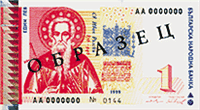 Obverse side of the 1 Bulgarian lev is showing a 1789 icon depicting of Saint Ivan Rilski from the Uspenie Bogorodichno Church in the Pchelino Postnica near the Rila Monastery. |
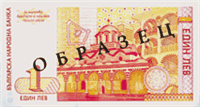 Reverse side of the 1 Bulgarian lev is showing the main Monastery church set off by the cloister’s open-air walkways. |
| 2 Bulgarian levs | |
|---|---|
| Banknote of 2 Bulgarian levs has dimensions 116×64 mm and main colors are old lavender, pastel purple, old rose, platinum and timberwolf. The 2 levs banknote paper consists of 100% cotton, in doublesided blue tones. | |
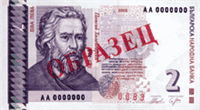 Obverse side of the 2 Bulgarian levs is showing an engraving of Pagisios of Chiliandar, the Zografou Monastery on Mount Athos, the Monastery Seal and the interior of Pagisios’ monastic cell |
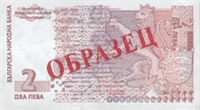 Reverse side of the 2 Bulgarian levs is showing a facsimile of the Zografou draft of the “Historiae Sclavo-Bulgaricus”, Hristofor Zhefarovich’s lion rampant and Bulgaria’s Coat of Arms with three lions couchant |
| 5 Bulgarian levs | |
|---|---|
| Banknote of 5 Bulgarian levs has dimensions 121×67 mm and main colors are old rose, fuzzy wuzzy, tumbleweed, isabelline and dark gray. The 5 levs banknote paper consists of 100% cotton, in pink tones. | |
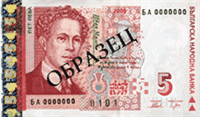 Obverse side of the 5 Bulgarian levs is showing the engraving of Ivan Milev, a noted Bulgarian 1920s artist. |
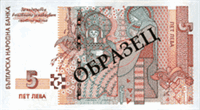 Reverse side of the 5 Bulgarian levs is showing fragments from his paintings „A Woman Harvesting”, „The Bulgarian Madonna”, and „Wedding of the Dragon”. |
| 10 Bulgarian levs | |
|---|---|
| Banknote of 10 Bulgarian levs has dimensions 126×70 mm and main colors are dim khaki, dark tan, grullo and gray (X11 gray). The 10 levs banknote paper consists of high quality banknote paper, toned in beige. | |
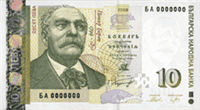 Obverse side of the 10 Bulgarian levs is showing the portrait of dr. Petar Beron, the vertical prints — „Петър Берон” (Petar Beron) and „1799–1871”, as well as the nominal value of the coin in figures and in words. |
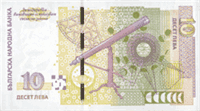 Reverse side of the 10 Bulgarian levs is showing sketches taken from Peter Beron’s treatises, his personal telescope, and the nominal value of the banknote in figures and in words |
| 20 Bulgarian levs | |
|---|---|
| Banknote of 20 Bulgarian levs has dimensions 131×73 mm and main colors are cool grey, pale aqua, lavender gray, tan and desert sand. The 20 levs banknote paper consists of high quality banknote paper, toned in blue. | |
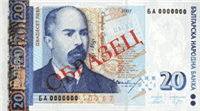 Obverse side of the 20 Bulgarian levs is showing the portrait of Stefan Stambolov, the vertical prints — „Стефан Стамболов” (Stefan Stambolov) and „1854-1895”, as well as the nominal value of the coin in figures and in words. |
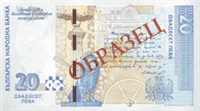 Reverse side of the 20 Bulgarian levs is showing the building of the National Assembly, fragments of Orlov Most (Eagles’ Bridge) and Luvov Most (Lions’ Bridge), and the nominal value of the banknote in figures and in words. |
| 50 Bulgarian levs | |
|---|---|
| Banknote of 50 Bulgarian levs has dimensions 136×76 mm and main colors are grullo, rosy brown, pale silver, isabelline and pale silver. The 50 levs banknote paper consists of high quality banknote paper, toned in reseda. | |
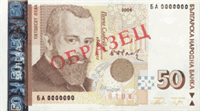 Obverse side of the 50 Bulgarian levs is showing the portrait of poet Pencho Slaveykov, fragments of the buildings of the National Theatre and the National Library. The texts „Пенчо Славейков” (Pencho Slaveykov) and „1866-1912” are printed vertically and the banknote’s nominal value is given in figures and in words. |
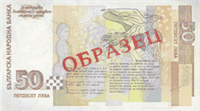 Reverse side of the 50 Bulgarian levs is showing texts from Pencho Slaveykov’s works, a bird illustration from one of his books of poetry, the figure of the poetess Mara Belcheva, and the banknote’s nominal value given in figures and in words. |
| 100 Bulgarian levs | |
|---|---|
| Banknote of 100 Bulgarian levs has dimensions 141×79 mm and main colors are pastel gray, light slate gray, feldgrau, peach puff and pale gold. The 100 levs banknote paper consists of high quality banknote bill stock tinted in pale green. | |
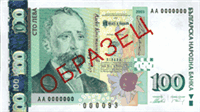 Obverse side of the 100 Bulgarian levs is showing the image of the writer Aleko Konstantinov along with emblematic motifs from the Bulgarian mountain trekking movement, and a facsimile of the first edition of A Journey to Chicago and Back. |
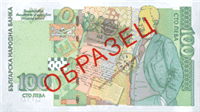 Reverse side of the 100 Bulgarian levs is showing items from the life and works of Aleko Konstantinov. |
Useful links
- About Bulgarian National Bank:
- Bulgarian National Bank
- List of currencies:
- Currencies
- Security and design features of BGN banknotes:
- BGN banknotes
- BGN currency on Wikipedia:
- Bulgarian lev
- Official Website of Bulgarian National Bank:
- www.bnb.bg
- Commemorative coins:
- Commemorative Coins